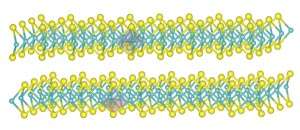Harnessingthe properties of a remarkable 2-D material

Characterizing the thermal properties of crystalline molybdenum disulfide, an important two-dimensional (2-D) material, has proven challenging. Now researchers from A*STAR have developed a simple technique that could pave the way for its use in a wide range of new applications in energy storage, optoelectronic and flexible electronic devices.
Hexagonal molybdenum disulfide (MoS2), one of the dichalcogenides—a family of semiconducting transitional metals—has attracted considerable attention as a two-dimensional (2-D) material thanks to its remarkable electronic and optoelectronic properties. It is also notable for its impressive strength and flexibility, which arise from the hexagonal lattice of molybdenum atoms sandwiched between layers of sulfur atoms.
Determining the thermal characteristics of MoS2 is key to unlocking its astonishing properties, but its complex geometry and the many required calculations for phonons—the different vibrational modes of atoms in a crystal lattice—are a costly and time-consuming computational process.
Chee Kwan Gan and Yu Yang Fredrik Liu from the A*STAR Institute of High Performance Computing have now developed a numerical technique that dramatically reduces the number of calculations, allowing the thermal expansion coefficient—which determine how their shape and size change in response to changes in temperature—of MoS2 crystals to be accurately and efficiently calculated, and could also be applied to other important 2-D materials.
"Think of a phonon as a particle tied to a spring, where it vibrates with a fixed pattern at a fixed frequency," explains Gan. "There are many phonon modes in a crystal like molybdenum disulfide, and the challenge is to calculate all of them."
By deforming a crystal of MoS2, the researchers determined the change in frequency for each phonon in the lattice structure, and by applying a numerical method, based on perturbation theory, to these altered frequencies; they were able to estimate the crystal's thermal characteristics, known as the Grüneisen parameters. These parameters were then used to calculate the thermal expansion coefficients for hexagonal MoS2.
"Our method uses the full symmetry of the hexagonal structure to reduce the amount of computation to only four sets of phonon calculations compared with quasi-harmonic approximation—the traditional approach—that requires many more," says Gan.
The work presents, for the first time, an accurate and simple method for determining the thermal properties of MoS2, and provides a deeper understanding of thermal conduction in 2-D materials.
"Our long-term aim is to extend the approach to other technologically important semiconducting, two-dimensional materials, such as bismuth selenide," says Gan.
More information: Chee Kwan Gan et al. Direct calculation of the linear thermal expansion coefficients ofMoS2via symmetry-preserving deformations, Physical Review B (2016). DOI: 10.1103/PhysRevB.94.134303
Journal information: Physical Review B

















